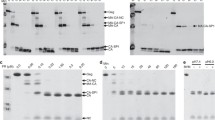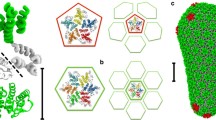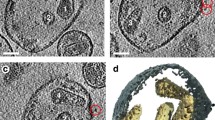Abstract
The assembly of the HIV-1 immature capsid (HIC) is an essential step in the virus life cycle. In vivo, the HIC is composed of \(\sim 420\) hexameric building blocks, and it takes 5–6 min to complete the assembly process. The involvement of numerous building blocks and the rapid timecourse makes it difficult to understand the HIC assembly process. In this work, we study HIC assembly in vivo by using differential equations. We first obtain a full model with 420 differential equations. Then, we reduce six addition reactions for separate building blocks to a single complex reaction. This strategy reduces the full model to 70 equations. Subsequently, the theoretical analysis of the reduced model shows that it might not be an effective way to decrease the HIC concentration at the equilibrium state by decreasing the microscopic on-rate constants. Based on experimental data, we estimate that the nucleating structure is much smaller than the HIC. We also estimate that the microscopic on-rate constant for nucleation reactions is far less than that for elongation reactions. The parametric collinearity investigation testifies the reliability of these two characteristics, which might explain why free building blocks do not readily polymerize into higher-order polymers until their concentration reaches a threshold value. These results can provide further insight into the assembly mechanisms of the HIC in vivo.



Similar content being viewed by others
References
Ayton GS, Voth GA (2010) Multiscale computer simulation of the immature HIV-1 virion. Biophys J 99(9):2757–2765
Briggs JA, Krässlich HG (2011) The molecular architecture of HIV. J Mol Biol 410(4):491–500
Carlson LA, Briggs JA, Glass B, Riches JD, Simon MN, Johnson MC, Müller B, Grünewald K, Kräusslich HG (2008) Three-dimensional analysis of budding sites and released virus suggests a revised model for HIV-1 morphogenesis. Cell Host Microbe 4(6):592–599
Caspar DL (1980) Movement and self-control in protein assemblies. Quasi-equivalence revisited. Biophys J 32(1):103–138
Caspar DL, Klug A (1962) Physical principles in the construction of regular viruses. Cold Spring Harbor Symp Quant Biol 27:1–24
Chen C, Kao CC, Dragnea B (2008) Self-assembly of brome mosaic virus capsids: insights from shorter time-scale experiments. J Phys Chem A 112(39):9405–9412
Dykeman EC, Stockley PG, Twarock R (2014) Solving a Levinthal’s paradox for virus assembly identifies a unique antiviral strategy. In: Proceedings of the national academy of sciences of the United States of America vol 111(14), p 201319,479
Endres D, Zlotnick A (2002) Model-based analysis of assembly kinetics for virus capsids or other spherical polymers. Biophys J 83(2):1217–1230
Freed EO (2013) Advances in HIV-1 assembly and release. Springer, New York
Freed EO (2015) HIV-1 assembly, release and maturation. Nat Rev Microbiol 13(8):484–496
Guo Y, Nie Q, Maclean AL, Li Y, Lei J, Li S (2017) Multiscale modeling of inflammation-induced tumorigenesis reveals competing oncogenic and onco-protective roles for inflammation. Cancer Res 77(22):6429–6441
Hagan MF (2013) Modeling viral capsid assembly. Adv Chem Phys 155:1
Hagan MF, Elrad OM (2009) Understanding the concentration dependence of viral capsid assembly kinetics-the origin of the lag time and identifying the critical nucleus size. Biophys J 98(6):1065–1074
Hagan MF, Zandi R (2016) Recent advances in coarse-grained modeling of virus assembly. Curr Opin Virol 18:36–43
Jarvis LM (2017) Conquering HIV’s capsid. Chem Eng News 95(31):23–25
Jin S, Wu F, Zou X (2017) Domain control of nonlinear networked systems and applications to complex disease networks. Discrete Contin Dyn Syst Ser B 22(6):2169–2206
Jin S, Wang D, Zou X (2018) Trajectory control in nonlinear networked systems and its applications to complex biological systems. SIAM J Appl Math 78(1):629–649
Johnson GT, Goodsell DS, Autin L, Forli S, Sanner MF, Olson AJ (2014) 3D molecular models of whole HIV-1 virions generated with cellPACK. Faraday Discuss 169:23–44
Johnston IG, Louis AA, Doye JP (2010) Modelling the self-assembly of virus capsids. J Phys Condens Matter Inst Phys J 22(10):104101
Jouvenet N, Bieniasz PD, Simon SM (2008) Imaging the biogenesis of individual HIV-1 virions in live cells. Nature 454(7201):236
Liu Y, Zou X (2017) Mathematical modeling and quantitative analysis of HIV-1 Gag trafficking and polymerization. Plos Comput Biol 13(9):e1005733
Liu Y, Zou X (2017) Mathematical modeling of HIV-like particle assembly in vitro. Mathe Biosci 288:46–51
Minton AP (2000) Implications of macromolecular crowding for protein assembly. Curr Opin Struct Biol 10(1):34–39
Misra N, Lees D, Zhang T, Schwartz R (2014) Pathway complexity of model virus capsid assembly systems. Comput Math Methods Med 9(3–4):277–293
Moisant P, Neeman H, Zlotnick A (2010) Exploring the paths of virus assembly. Biophys J 99(5):1350–1357
Mukherjee S, Thorsteinsson MV, Johnston LB, Dephillips PA, Zlotnick A (2008) A quantitative description of in vitro assembly of human papilloma virus 16 virus-like particles. J Mol Biol 381(1):229–237
Munozalicea R (2013) HIV-1 Gag trafficking and assembly: mathematical models and numerical simulations. Dissertations and Theses—Gradworks
Pak AJ, Jma G, Sengupta P, Chen AK, Aep D, Srivastava A, Yeager M, Jag B, Lippincott-Schwartz J, Voth, GA (2017) Immature HIV-1 lattice assembly dynamics are regulated by scaffolding from nucleic acid and the plasma membrane. In: Proceedings of the national academy of sciences of the United States of America vol 114(47), p 20170600
Perlmutter JD, Hagan MF (2014) Mechanisms of virus assembly. Annu Rev Phys Chem 66(1):217
Perlmutter JD, Hagan MF (2015) The role of packaging sites in efficient and specific virus assembly. J Mol Biol 427(15):2451–2467
Perlmutter JD, Cong Q, Hagan MF (2013) Viral genome structures are optimal for capsid assembly. Elife 2(13):e00632
Perlmutter JD, Perkett MR, Hagan MF (2014) Pathways for virus assembly around nucleic acids. J Mol Biol 426(18):3148–3165
Prevelige PE, Thomas D, King J (1993) Nucleation and growth phases in the polymerization of coat and scaffolding subunits into icosahedral procapsid shells. Biophys J 64(3):824
Rapaport DC, Johnson JE, Skolnick J (1999) Supramolecular self-assembly: molecular dynamics modeling of polyhedral shell formation. Comput Phys Commun 121–122(3):231–235
Rasband W (2013) ImageJ. https://imagej.nih.gov/ij/
Sadre-Marandi F, Liu Y, Liu J, Tavener S, Zou X (2015) Modeling HIV-1 viral capsid nucleation by dynamical systems. Math Biosci 270:95–105
Schur FKM, Hagen WJH, Rumlová M, Ruml T, Müller B, Kräusslich HG, Briggs JAG (2015) Structure of the immature HIV-1 capsid in intact virus particles at 8.8 Å resolution. Nature 517(7535):505–508
Schwartz R, Shor PW, Prevelige PE, Berger B (1998) Local rules simulation of the kinetics of virus capsid self-assembly. Biophys J 75(6):2626–36
Tan Z, Pionek K, Unchwaniwala N, Maguire ML, Loeb DD, Zlotnick A (2015) The interface between hepatitis B virus capsid proteins affects self-assembly, pregenomic RNA packaging, and reverse transcription. J Virol 89(6):3275–3284
Tritel M, Resh MD (2000) Kinetic analysis of human immunodeficiency virus type 1 assembly reveals the presence of sequential intermediates. J Virol 74(13):5845–5855
Tzlil S, Deserno M, Gelbart WM, Ben-Shaul A (2004) A statistical thermodynamic model of viral budding. Biophys J 86(4):2037–2048
van der Schoot P, Zandi R (2007) Kinetic theory of virus capsid assembly. Phys Biol 4(4):296–304
van der Schoot P, Zandi R (2013) Impact of the topology of viral RNAs on their encapsulation by virus coat proteins. J Biol Phys 39(2):289–299
Wagner J, Zandi R (2015) The robust assembly of small symmetric nanoshells. Biophys J 109(5):956–965
Wang D, Zou X (2018) A new centrality measure of nodes in multilayer networks under the framework of tensor computation. Appl Math Model 54:46–63
Zhang W, Zou X (2015) A new method for detecting protein complexes based on the three node cliques. IEEE/ACM Trans Comput Biol Bioinform 12(4):879–886
Zlotnick A (1994) To build a virus capsid. An equilibrium model of the self assembly of polyhedral protein complexes. J Mol Biol 241(1):59–67
Zlotnick A (2005) Theoretical aspects of virus capsid assembly. J Mol Recognit 18(6):479–490
Zlotnick A, Johnson JM, Wingfield PW, Stahl SJ, Endres D (1999) A theoretical model successfully identifies features of hepatitis B virus capsid assembly. Biochemistry 38(44):14644–14652
Acknowledgements
The authors thank the anonymous reviewers for their valuable comments and suggestions. This work was supported by the Key Program of the National Natural Science Foundation of China (No. 11831015) and the Chinese National Natural Science Foundation (No. 61672388).
Author information
Authors and Affiliations
Corresponding author
Additional information
Publisher's Note
Springer Nature remains neutral with regard to jurisdictional claims in published maps and institutional affiliations.
Appendix
Appendix
Theorem 1
The positive equilibrium point of the model (1) exists and is unique.
Proof
Let the right-hand sides of the model (1) equal zero.
From the last equation of Eq. (6), we can obtain
By adding the last two equations of Eq. (6), we can obtain
In the same way, we can obtain
By substituting Eqs. (9) , (8) and (7) into the first equation of Equations (6), we obtain
By substituting Eq. (10) into the last equation of Eq. (9), we obtain
By substituting Eqs. (10) and (11) into the penultimate equation of Eq. (9), we obtain
In the same way, we can obtain
By substituting the last equation of Eq. (13) into Eq. (10), we obtain
Let the right-hand side of Eq. (14) be f([H])
Because \(f'([H])\) has both positive and negative terms, it is possible that \(f'([H])\) is not a monotone function. It is difficult to proof its monotony by \(f'([H])>0\) or \(f'([H])<0, H\in (0,+\infty )\), directly.
In Eq. (15), we find that only the coefficient of the highest-order term of f([H]) is positive, and the other terms are all negative. If we convert the only positive term into a constant, its derivative will become zero. As a result, all terms in its derivative will become negative and the monotonicity of this new function will be easy to proof.
Based on the above analysis, let
Obviously, \(F([H])=0\) and \(f([H])=0\) for \(H>0\) have the same solutions.
The derivative of F([H]) is
Because \(k_{i}^{\pm }>0,v>0,r>0\), \({F}'([H])>0\), for \([H]\in (0,+\infty )\). As a result, \(y=F([H])\) is a strictly monotone increasing function in \((0,+\infty )\). In addition,
Therefore, there is a unique positive solution denoted by \([{{H}^{*}}]\) for \(F([H])=0\). Because \(F([H])=0\) and \(f([H])=0\) in \((0,+\infty )\) have the same solution, \([{{H}^{*}}]\) is also the unique positive solution of \(f([H])=0\). Therefore, the positive equilibrium point of the model (1) exists and is unique.
Theorem 2
At equilibrium, the concentration of \(H_N\) is independent of two microscopic on-rate constants \(f_{\mathrm{nuc}}\) and \(f_{\mathrm{elong}}\), and the concentration of free hexamers increases as \(f_{\mathrm{nuc}}\) and \(f_{\mathrm{elong}}\) decrease.
Proof
From Eq. (10), we can obtain
We can obviously see that the concentration of \(H_N\) at equilibrium does not depend on two microscopic on-rate constants \(f_{\mathrm{nuc}}\) and \(f_{\mathrm{elong}}\).
Based on Eq. (2), we can obtain
which is independent of \(f_{\mathrm{nuc}}\) and \(f_{\mathrm{elong}}\). So, in Eq. (16), the constant term of F([H]) is independent of \(f_{\mathrm{nuc}}\) and \(f_{\mathrm{elong}}\). But the coefficients of the other terms all have the factor \(-\frac{1}{k_{i}^{-}}\). Because \(k_{i}^{-}={{f}_{\mathrm{nuc}}}{{\sigma }_{i}}K_{\mathrm{Acon}}^{-{{c}_{i}}}\) or \(k_{i}^{-}={{f}_{\mathrm{elong}}}{{\sigma }_{i}}K_{\mathrm{Acon}}^{-{{c}_{i}}}\) in Eq. (2), the coefficients of these terms in F([H]) will decrease as \(f_{\mathrm{nuc}}\) and \(f_{\mathrm{elong}}\) decrease. As a result, F(H) will decrease as \(f_{\mathrm{nuc}}\) and \(f_{\mathrm{elong}}\) decrease. In addition, \(y=F([H])\) is a strictly monotone increasing function in \((0,+\infty )\). Therefore, the unique positive solution of \(F([H])=0\) will increase as \(f_{\mathrm{nuc}}\) and \(f_{\mathrm{elong}}\) decrease. So, at equilibrium, the concentration of free building blocks increases as \(f_{\mathrm{nuc}}\) and \(f_{\mathrm{elong}}\) decrease.
Rights and permissions
About this article
Cite this article
Liu, Y., Zou, X. A New Model System for Exploring Assembly Mechanisms of the HIV-1 Immature Capsid In Vivo. Bull Math Biol 81, 1506–1526 (2019). https://doi.org/10.1007/s11538-019-00571-7
Received:
Accepted:
Published:
Issue Date:
DOI: https://doi.org/10.1007/s11538-019-00571-7




